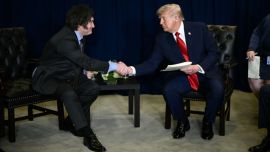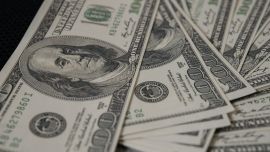Argentina’s government sold dollars in the spot market on Wednesday to stem a slump in the peso that is now in its third day, according to two people with direct knowledge of the matter.
The government sold more than US$450 million, one of the people said, limiting the drop in the peso to 3.1 percent against the dollar. The Central Bank was identified as the seller, but it often acts as the Treasury’s financial agent in the local currency market, the people added.
It’s the second day that President Javier Milei’s government has intervened in the spot market. On Tuesday, it sold dollars before buying the greenback in block trades outside the market, ending the day with a net balance of US$30 million in purchases.
The sales highlight the strain the peso is under, even after the US pledged aid and local authorities reintroduced capital restrictions late last week, including a 90-day ban on reselling dollars. Investors have noticed a sharp increase in demand for dollars from individuals, who are taking advantage of a rally in the currency last week that followed a flood of dollars into the market from agricultural exports.
Central Bank reserves leaped by US$1.9 billion on Wednesday to US$42.2 billion after commercial banks moved to fulfill their reserve requirements on the last day of September. The move happens every month and didn’t reflect an increase in net reserves.
An agreement with the International Monetary Fund bars the central bank from using those reserves to intervene within the peso’s trading band, which on Wednesday went from 945 to 1,481 per dollar. The peso’s sharp slide left it near the top end of that band, narrowing the government’s room for maneuver.
Argentina’s Central Bank declined to comment, while the Economy Ministry didn’t respond to a request for comment.
The country’s dollar bonds were down across the curve for a fifth day on Wednesday, though they pared losses in the afternoon session. Notes maturing in 2035 fell as much as two cents before trimming the drop as the exchange rate stabilized, trading just below 52 cents on the dollar, according to indicative pricing data compiled by Bloomberg.
by Ignacio Olivera Doll, Bloomberg



















Comments